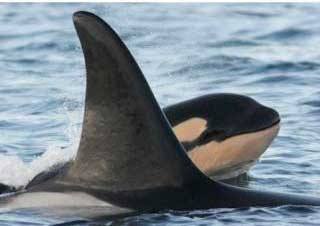The final resting place of L112 will be far from where the 3-year-old killer whale washed up on a beach in southern Washington, its body battered, bloodied and bruised.
In fact, local marine biologists hope that, despite its sad end, the young female orca will add to a growing body of research and help spark even greater interest in the marine mammals after her remains are shuttled to San Juan Island.
According to Amy Traxler of The Friday Harbor Whale Museum, coordinator of San Juan County Marine Mammal Stranding Network, federal officials will turn over the remains of L112 to the museum sometime in the next few weeks. Traxler said the museum intends to showcase L112’s skeleton as part of an educational exhibit that’s reminiscent of a grey whale that’s long-been on display.
“It’s a very sad and unfortunate how her life ended,” Traxler said. “This is a rare opportunity though, and we’re excited we’ll be able to take possession of its remains.”
The cause of death of the 3-year-old orca has yet to be determined. Its body was found on a beach just north of Long Beach, Wash., Feb. 11. Its body was battered and bruised, however. Traxler said that the injuries appear inconsistent with what would be expected if it had been attacked by predatory killer whales. The injuries are also somewhat inconsistent with what would be expected if the killer whale had been fatally struck by a ship, she said.
“It’s a bit of a mystery at the moment,” Traxler said. “We may never really know.”
Born in early 2009, L-112 is a calf of L-86, and it was traveling in the company of other members of the southern Residents when it was first photographed off the shore of Victoria, B.C, by the San Juan Island-based Center for Whale Research. L-112 was one of five southern Resident calves born that year.
It had grown to just over 12 feet in length in three years. A necropsy, similar to an autopsy, was conducted Feb. 12, the day after the body of L-112 was discovered. Results are expected in the next several weeks, or perhaps months, according to National Marine Fisheries Service.
Listed as endangered in the U.S. in 2005, the southern residents consist of three tightly knit clans, known as J, K and L pods. They were declared endangered in the wake of the population’s 20 percent decline in the mid 1990s. As of 2010, the population totaled 87 animals, according to the Center. The southern Residents are designated as endangered by Washington state and in Canada as well.
Dr. Joe Gaydos of SeaDoc Society notes recovery of a killer whale carcass is somewhat rare.
He said from 1974 to 2008, that the bodies of only 21 percent of the Southern Resident killer whales that have gone missing, and presumably died, were ever found. At 3 percent, the recovery rate for Northern Resident killer whales is much lower, he said.
A battery of tests and research are being conducted on just about every aspect of the animal, he added.
“It’s a shame it died,” Gaydos said. “But if there’s a silver lining it’s that we’re leaving no stone left unturned and its death will help build our scientific understanding of the species and education for the public.”




